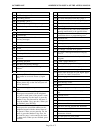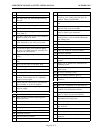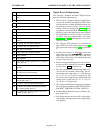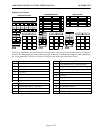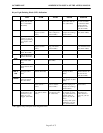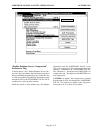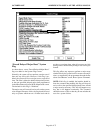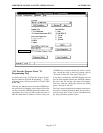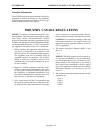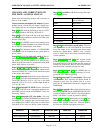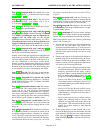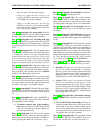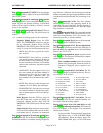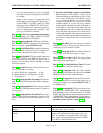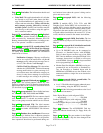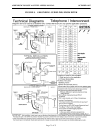
ADDENDUM TO ISSUE 4 OF THE AXXESS MANUALOCTOBER 1997
Page 68 of 73
Page 3–59, paragraph 8.18: The middle part of the
sentence should read: ...(as measured in step 6 on page
3–48, 3–51, or 3–54)...
Page 3–59, paragraph 8.18, step 2: The end of the
sentence should read: ...(see Figure 3–30, 3–31, or
3–32 on page 3–49, 3–52, or 3–55).
Page 3–75, step 11: Some keyset models (even newer
ones) do not have potentiometers.
Page 3–78, paragraph 9.10, step 4 and page 3–80,
paragraph 9.12, step 4: Add the following note to step
four. NOTE: If installing the unit on a digital keyset
equipped with red LEDs only, use the original
PCDPM-to-keyset interface cable (part no. 813.1567).
If installing the unit on one of the new digital keysets
equipped with both red and green LEDs, use the new
cable (part no. 813.1634) now included with each unit.
Page 3–78, paragraph 9.10, step 3 and page 3–80,
paragraph 9.12, step 3: Add the following informa-
tion to the note following step three:
Initially, some of the new digital keysets equipped with
both red and green LEDs did not have a plastic knock-
out in the upper portion of the back of the keyset to al-
low easy connection to the keyset control board.
Instead, you must open the back of the keyset (secured
by four screws) and route the cable through the plastic
knockout in the lower portion of the back housing, just
as you would if you were wall-mounting the keyset.
Page 3–107, step 5b: The first part of the sentence
should read: Depending on which number VPC (1–3)...
Page 3–121, paragraph 13.2, step 6a (the second
one): The end of the sentence should read: ...(default is
91000 for the CPU 256 or CPU 512 Master and 91001
for the CPU 512 Slave).
Page 4–6, Default Station feature code: The descrip-
tion should read: This single feature code cancels ac-
count code for all calls following, do-not-disturb,
manual call forwarding, background music, ring inter-
com always, and queue requests. It restores handsfree
mode, pages, hunt group calls, and system forwarding
and it returns keyset volumes to default values.
Page 4–11, paragraph 4.3, second bullet: The first
sentence should be: If the call is not seized and not sent
to a station, the caller will hear ringing until he or she
hangs up.
Page 4–12, paragraph 4.12: It should read as follows:
If a station user transfers or forwards an outside call to
an outside telephone number, it becomes an “unsuper-
vised” CO-to-CO call because no inside parties are in-
volved. The CO-to-CO call is limited by the Unsuper-
vised CO timer. When the timer expires, the call recalls
the primary attendant station and causes the CNF key
to flash...
Page 4–12, paragraph 4.15: Add the following sen-
tence: The Unsupervised CO timer is ignored and the
Abandoned Call timer is determines how long the call
will recall the station before it is disconnected.
Page 4–12, paragraph 5.4: Addthistotheendofthe
paragraph: There can be up to 5000 entries in a triple-
or quad-cabinet system.
Page 4–13, paragraph 6.7: Several minor changes
have been made to make the hunt group explanation
clearer. The new information should read as follows:
Hunt group stations receive the following indications
when a call is ringing in:
•
If an outside call is ringing, the station designated to
receive the call first shows ring flash on the
associated individual trunk key (if it has one) or a
Call key until the call is answered or the No Answer
Advance timer expires and the call moves to the
next station.
•
If hunt group camp on is allowed and all stations on
the hunt group list are unavailable (busy, in do-not-
disturb, or with hunt group remove enabled), an in-
tercom or outside call will camp on and the stations
will receive the following indications:
— Busy stations receive hunt group camp-on tones
(if enabled) and display. If there is an individual
trunk key associated with the trunk, it shows
ring flash. (There is a programmable station flag
that can disable the camp-on tones for hunt
group calls. See PROGRAMMING, page 6–31.)
— Stations with Hunt Group Remove enabled re-
ceive camp-on tones and display. If there is an
individual trunk key associated with the trunk, it
shows ring flash.
— Stations with Do-Not-Disturb enabled receive
no camp-on indications, but if there is an indi-
vidual trunk key associated with the trunk, it
shows ring flash.
— The first station that becomes available receives
ringing and a flashing trunk or Call key. The
camp-on and ring flash indications end at the
other stations. (The associated trunk key will be
steadily lit at those stations to show that the
trunk is busy.)
•
If hunt group camp on is not allowed and all sta-
tions on the hunt group list are unavailable, the hunt
group members will not have any camp-on indica-
tions. (See page 6–86 for camp-on flag program-
ming information.) Callers will hear one of the fol-
lowing:



